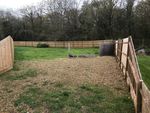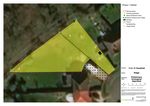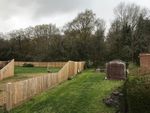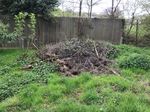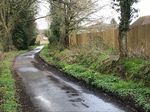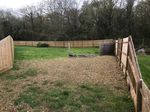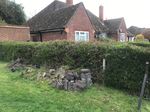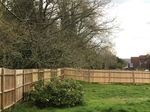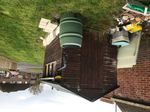Preliminary Ecological Appraisal 14 - 15 Yeosfield, Riseley On behalf of Ridge and Partners LLP April 2019 - Wokingham Borough Council
←
→
Page content transcription
If your browser does not render page correctly, please read the page content below
Preliminary Ecological
Appraisal
14 – 15 Yeosfield, Riseley
On behalf of Ridge and Partners LLP
April 2019
Ecology by Design Ltd,
Hampden House, Monument Park, Chalgrove, Oxon OX44 7RW.
Tel 01865 893346 www.ecologybydesign.co.ukProject Code Title Date of Issue
EBD00830 14 – 15 Yeosfield, Riseley 11th April 2019
Name Date
Prepared by Emily Power BSc (Hons) MSc Grad CIEEM 10th April 2019
Checked by Ben Gardner BSc (Hons) MCIEEM CEnv 10th April 2019
Copyright Ecology by Design Ltd. All rights reserved.
No part of this report may be copied or reproduced by any means without prior written consent from
Ecology by Design Ltd. If you have received this report in error please destroy all copies in your possession
or control and notify Ecology by Design Ltd.
This report has been commissioned for the exclusive use of the commissioning party unless otherwise
agreed in writing by Ecology by Design Ltd; no other party may use, make use of or rely on the contents
of the report. No liability is accepted by Ecology by Design Ltd for any of this report, other than for the
purposes for which it was originally prepared and provided.
Opinions and information provided in this report are on basis of Ecology by Design Ltd using due skill, care
and diligence in the preparation of this report and no explicit warranty is provided as to its accuracy. It
should be noted that no independent verification of any of the documents or information supplied to
Ecology by Design Ltd has been made.Contents 1 Executive Summary ..................................................................................................................... 3 1.1 Recommendations ...................................................................................................................... 3 Introduction ......................................................................................................................................... 4 1.2 Background and Survey Objectives ............................................................................................ 4 1.3 Site Description ........................................................................................................................... 4 1.4 Proposed Works ......................................................................................................................... 4 1.5 Limitations/ Constraints ............................................................................................................. 5 2 Methods ...................................................................................................................................... 5 2.1 Desk Study .................................................................................................................................. 5 2.2 Preliminary Ecological Appraisal ................................................................................................ 5 3 Results ......................................................................................................................................... 5 3.1 Desk Study .................................................................................................................................. 5 3.2 Phase 1 Habitat Survey............................................................................................................. 12 3.3 Protected Species Survey Results.............................................................................................. 13 4 Discussion .................................................................................................................................. 15 4.1 Evaluation and Impacts ............................................................................................................ 15 5 Recommendations and Mitigation strategy ............................................................................... 16 6 Relevant Legislation and Policy .................................................................................................. 18 6.1 European Protected Sites ......................................................................................................... 18 6.2 Natural Environment & Rural Communities Act 2006 .............................................................. 18 6.3 National Planning Policy Framework ....................................................................................... 18 6.4 Local Planning Policy ................................................................................................................ 19 6.5 Hedgerows ............................................................................................................................... 20 6.6 Protected Species ..................................................................................................................... 20 7 References ................................................................................................................................. 22 Appendix 1 - Photographs .................................................................................................................. 23 Appendix 2 – Site Plan ....................................................................................................................... 25 Appendix 3 – Species List ................................................................................................................... 26 Appendix 4 – Definitions of the level of Habitat Value ....................................................................... 28 Appendix 5 – Definitions of the level of Species Value........................................................................ 29 Appendix 6 – Enhancements .............................................................................................................. 30
1 Executive Summary
Ecology by Design Ltd was commissioned by Ridge and Partners LLP to undertake a Preliminary Ecological
Appraisal of land known as 14 – 15 Yeosfield, in Riseley, Reading, RG7 1SG (SU 71993 63133). The client
seeks planning permission for the construction of a residential dwelling.
• The site was formed of amenity grassland, hard-standing, building and species-poor hedgerow.
Scattered trees overhung the site on the northern boundary;
• The site was adjacent to the St Leger’s Copse local wildlife site;
• The scattered trees had the potential to provide foraging and commuting opportunities for bats;
and
• The scattered trees and species-poor hedgerow had the potential to support nesting birds.
1.1 Recommendations
• An arborist should be contacted to devise a strategy to protect the trees along the northern
boundary from any impacts of the development;
• If any works are required to the trees along the northern boundary, an assessment for bats must
be undertaken, which may comprise an initial aerial survey and potentially further surveys to
determine the type of roost present;
• A lighting strategy should be devised to ensure that there is no light spill on the trees on the
northern boundary of the site;
• All vegetation clearance of trees and hedgerows should be undertaken outside the breeding bird
season, which is considered to be March – August inclusive;
• Brash piles should be dismantled by hand to avoid injury to reptiles;
• Any trenches should be closed overnight, or a ramp installed to allow hedgehogs the opportunity
to escape;
• Recommendations for ecological enhancements are included within Chapter 6 of this report,
including incorporation of a planting scheme using native plants, construction of log piles and
installation of bat boxes on mature trees around the site; and
• Should potential development not commence within 2 years of this report a resurvey is
recommended due to the potential for the ecological interest of the site to change.
Ecology by Design Ltd Page | 3 Reference: EBD00830Introduction
1.2 Background and Survey Objectives
Ecology by Design Ltd was commissioned by Ridge and Partners LLP to undertake a Preliminary Ecological
Appraisal of land known as 14 – 15 Yeosfield, in Riseley, Reading, RG7 1SG (SU 71993 63133). The client
seeks planning permission for the construction of a residential dwelling.
The aim of the survey and supporting desk study was to satisfy the requirements of the National Planning
Policy Framework and relevant legislation and to identify ecological features within or near the site that
could potentially pose a constraint to the proposed works and highlight any opportunities for
incorporating biodiversity enhancements into the proposals.
The objectives of this report are:
• To identify designated nature conservation sites within the vicinity of the site;
• To identify any records and/or populations of protected, notable or scarce species in the vicinity
of the site;
• To record habitats or features of ecological interest within or in immediate proximity of the site;
• To record the presence of, or potential for, protected or notable species;
• To make an ecological assessment and highlight potential ecological constraints;
• To outline any further survey work and potential protected species requirements if relevant; and
• To make suggestions for mitigation and compensation where appropriate.
1.3 Site Description
The site extends to approximately 0.07 hectares and comprises fenced areas of amenity grassland. There
are mature trees outside the site boundary along the northern boundary of the site. The site is situated
on the western side of the town of Riseley, between residential properties on a residential cul-de-sac,
immediately south of St Leger’s Copse local wildlife site. The wider landscape comprises the residential
area of Riseley to the south and east, and woodlands and agricultural fields to the west and north,
interlinked by hedgerows.
1.4 Proposed Works
The proposal is for a two storey detached residential dwelling with associated gardens and car parking.
The building is to be situated to the south of the site and therefore should be clear of the trees along the
northern boundary.
Ecology by Design Ltd Page | 4 Reference: EBD008301.5 Limitations/ Constraints
The wildlife and wider ecological interest of a site can change. The report presented here is a statement
of the findings of a survey carried out during April 2019. Any appreciable delay in making reference to this
report may necessitate a re-survey.
Weather conditions were considered suitable to conduct the survey.
2 Methods
2.1 Desk Study
A desk study was carried out to identify statutory and non-statutory designated sites within 7km
(Internationally designated sites) and 5km (Nationally designated sites) and records of protected or
notable species within 2km of the site.
Sources consulted include:
• Thames Valley Environmental Records Centre (http://www.tverc.org)
• Hampshire Biodiversity Information Centre
(https://www.hants.gov.uk/landplanningandenvironment/environment/biodiversity/informatio
ncentre)
• MAGIC (www.magic.gov.uk)
• Habitats and Species of Principal Importance
• Local Planning Policy documents
2.2 Preliminary Ecological Appraisal
A preliminary ecological appraisal was conducted on 3rd April 2019 by Ecology by Design ecologist Emily
Power and assistant ecologist Beth England using standard techniques and methodologies and the
nomenclature of Stace (2010). The PEA includes a survey of the habitats utilising the standard phase 1
habitat survey methodology (JNCC, 2007) as well as a scoping assessment of the presence of, or potential
for protected and notable species. Where potential impacts are identified the PEA is extended to include
an assessment of impact and mitigation required.
3 Results
3.1 Desk Study
There was one internationally designated site within 7km of the search area, three nationally designated
sites within 5km and eleven locally designated sites within 2km.
Ecology by Design Ltd Page | 5 Reference: EBD00830There are three statutory designated sites within the search area and fifteen non-statutory sites.
Table 1. Statutory designated sites
Site Name Designations Distance (km) Direction
Thames Basin Heaths SPA 2.4 E
Stanford End Mill and River Loddon SSSI 1.3 W
Bramshill SSSI 2.3 E
Hazeley Heath SSSI 4.1 SE
Swallowfield Meadow LNR 1.6 NE
SPA- Special Protection Area
SSSI - Site of Special Scientific Interest
Table 2. Non-statutory designated sites
Site Name Designations Distance (km) Direction
River Loddon and Lower Mill Fen SINC 1.8 SW
Stratfield Saye Lake SINC 1.4 W
The Plantation, Heckfield SINC 1.5 S
New Inn Copse, Heckfield SINC 0.6 S
Coldharbour Wood SINC 0.2 S
South of Birchen Copse SINC 1.3 SE
Birchen Copse and Mill Wood SINC 0.9 E
Wellington Country Park Lakes SINC 1 E
River Whitewater SINC 1.9 E
St Leger’s Copse, Collin’s Copse LWS 0.01 N
Highgrove Copse LWS 0.7 NW
Wood and Ditch/Moat LWS 1.7 NW
Ecology by Design Ltd Page | 6 Reference: EBD00830The Marshes, Riseley LWS 1.4 E
LWS – Local Wildlife Site
SINC – Site of Importance for Nature Conservation
Thames Basin Heaths SPA is a complex of heathlands in southern England and was designated for
supporting the following Annex 1 species: Dartford warbler (Sylvia undata), nightjar (Caprimulgus
europaeus) and woodlark (Lullula arborea).
Stanford End Mill and River Loddon SSSI was designated for its waterlogged hay meadows and stretch of
the River Loddon, which support nationally important populations of fritillary (Fritillary meleagris) and the
Loddon pondweed (Potamogeton nodosus).
Bramshill SSSI was designated for its series of shallow acid ponds and mire, and a conifer plantation which
supports nightjar, woodlark and Dartford warbler.
Hazeley Heath SSSI was designated for its range of heathland plant communities.
The site falls within the Impact Risk Zones of the surrounding SSSIs and the SPA.
Swallowfield Meadow LNR was designated for its meadows which are rich in plant and wildlife diversity,
including supporting water vole.
The Local Wildlife Sites were largely designated for supporting hedgerows, woodlands and ponds. The
most relevant local wildlife site to this site is St Leger’s Copse which is an area of ancient woodland located
on the other side of Bull Lane from the site. The SINCs were designated for supporting species including
water speedwell (Veronica anagalis-aquatica), gadwall (Anas strepera), Eurasian hobby (Falco subbuteo)
and tawny sedge (Carex hostiana).
Table 2. Records of selected protected or notable species within 2km of the site from Hampshire
Biodiversity Information Centre:
Distance
Species Type Designation Date Direction Location
(km)
Barn Owl HBIC WCA1 2010 1.9 SW Stratfield Saye Park
Brambling HBIC WCA1 2008 0.5 E Riseley
Cuckoo HBIC BOCC Red 2017Fieldfare HBIC BOCC Red 2017 1.9 SW Stratfield Saye Park
WCA1
Firecrest HBIC WCA1 2016 1.9 SW Stratfield Saye Park
HBAP
Grey Wagtail HBIC BOCC Red 2004 1.9 SW Stratfield Saye Park
House Sparrow HBIC BOCC Red 2011S41
Eurasian Badger HBIC PBA 2014 N/A N/A N/A
Brown Long-eared HBIC EPS 2010 0.9 S N/A
Bat S41
WCA5
Myotis spp HBIC EPS 2010 0.9 S N/A
S41
WCA5
HBAP
Noctule Bat HBIC EPS 2010 0.9 S N/A
S41
WCA5
Pipistrelle HBIC EPS 2010 0.9 S N/A
WCA5
HBAP
Serotine HBIC EPS 2010 0.9 S N/A
WCA5
HBAP
Soprano Pipistrelle HBIC EPS 2010 0.9 S N/A
S41
WCA5
EPS = European Protected Species (Annex 4)
EPS2 = European Protected Species (Annex 2)
PBA = Protection of Badgers Act
WCA5 = Wildlife and Countryside Act 1981 Schedule 5 Species
WCA1 = Wildlife and Countryside Act 1981 Schedule 1 Species
BOCC: amber/red = Birds of Conservation Concern
S41 = Natural Environment and Rural Communities Act section 41 species
HBAP = Hampshire Biodiversity Action Plan
Ecology by Design Ltd Page | 9 Reference: EBD00830Table 3. Records of selected protected or notable species within 2km of the site from Thames Valley
Environmental Records Centre:
Distance
Species Type Designation Date Direction Location
(km)
Great Crested TVERC EPS 2015 1.5 N Basingstoke Road,
Newt Swallowfield
WCA5
S41
Palmate Newt TVERC WCA5 2008 1.4 E School lane,
Swallowfield
Smooth Newt TVERC WCA5 2008 1.4 E School lane,
Swallowfield
Grass Snake TVERC WCA5 2010 1.3 W River Loddon
Stanford End SSSI
S41
Barn Owl TVERC WCA1 2007 1.6 N Wyvols Court
Farm, Swallowfied
Bullfinch TVERC S41 2005 1.6 N Swallowfield
BOCC Amber
Fieldfare TVERC WCA1 2004 1.6 N Swallowfield
BOCC Red
House Martin TVERC BOCC Amber 2005 1.6 N Swallowfield
House Sparrow TVERC S41 2005 1.6 N Swallowfield area
BOCC Red
Linnet TVERC S41 2005 1.6 N Swallowfield
BOCC Red
Red Kite TVERC WCA1 2005 1.6 N Swallowfield
Ecology by Design Ltd Page | 10 Reference: EBD00830Song Thrush TVERC S41 2004 1.6 N Swallowfield
BOCC Red
Spotted TVERC S41 2005 1.6 N Swallowfield
Flycatcher
BOCC Red
Yellowhammer TVERC S41 2005 1.6 N Swallowfield
BOCC Red
Eurasian Badger TVERC PBA 2013S41
Noctule spp TVERC EPS 20173.2.2 Amenity grassland The majority of the site was formed of amenity grassland, characterised by managed perennial rye-grass (Lolium perenne) and Yorkshire-fog (Holcus lanatus), with forbs throughout the sward including cleavers (Galium aparine), nettles (Urtica dioica) and thistle (Cirsium sp.). There were patches particularly around the site boundaries where forbs were more common, which included red dead-nettle (Lamium purpureum), lesser celandine (Ficaria verna), lord’s-and-ladies (Arum maculatum) and garlic mustard (Alliaria petiolata). 3.2.3 Building There a single shed at the site, which was wooden and used for storage purposes. 3.2.4 Hard-standing There was an area of hard-standing at the south of the site which comprised gravel for car parking purposes. 3.2.5 Species-poor hedgerow There was one species-poor hedgerow on the south-eastern boundary of the site which comprised cotoneaster (Cotoneaster sp.) and ornamental shrubs. 3.2.6 Fence Bisecting the centre of the site and surrounding the western and northern site boundaries was a wooden fence. 3.2.7 Target Notes Target Note 1 refers to a bonfire heap which was present on site, and Target Note 2 refers to a brash pile. 3.3 Protected Species Survey Results 3.3.1 White-clawed crayfish There was no suitable habitat for white-clawed crayfish (Austropotamobius pallipes) and there were also no records within 2km of the site. 3.3.2 Great crested newts The amenity grassland on site was of low suitability for great crested newts, as the grassland was managed, with very few potential resting opportunities. The closest ponds were located over 700m to the east, on the other side of the residential area of Riseley. There were records of great crested newts, however the closest of these was located 1.5km to the north. Ecology by Design Ltd Page | 13 Reference: EBD00830
3.3.3 Reptiles The grassland on site was of low suitability for reptiles due to the close management of the grassland. There were records for grass snake within 2km of the site, however these were from the Stanford End Mill and River Loddon SSSI. 3.3.4 Birds There were opportunities for nesting birds within the scattered trees and the species-poor hedgerow. House sparrows (Passer domesticus) were observed within the hedgerow during the site visit. There were records of a variety of birds in the vicinity including song thrush (Turdus philomelos) and starling (Sturnus vulgaris), as well as records of Schedule 1 species including barn owl (Tyto alba) and red kite (Milvus milvus). 3.3.5 Bats There were records of common pipistrelle (Pipistrellus pipistrellus), soprano pipistrelle (Pipistrellus pygmaeus), brown long-eared bat (Plecotus auritus), myotis (Myotis sp.), serotine (Eptesicus serotinus) and noctule (Nyctalus noctula) within 2km of the site. There were mature trees along the northern boundary of the site with the potential to support bats due to the presence of potential roost features. The shed on site did not have any potential for bats as there were no roosting features externally, and the only access feature was the open window, however this was blocked by stored materials within the shed. The scattered trees along the northern boundary offered suitable foraging and commuting habitat for bats. 3.3.6 Hazel dormouse There were no records of hazel dormice (Muscardinius avellanarius) within 2km of the site. There is potential for dormice to be present within the woodland to the north of the site across the road, however there is no suitable habitat on the site itself. 3.3.7 Water vole There were records of water vole (Arvicola amphibius) within 2km of the site associated with the River Loddon, however there were no waterbodies suitable for water vole on the site itself. 3.3.8 Badger There were no signs of badger (Meles meles) noted during the survey such as setts, runs or latrines, however there were records within 2km of the site. Ecology by Design Ltd Page | 14 Reference: EBD00830
3.3.9 Otter There were no records of otter (Lutra lutra) within 2km of the site and no suitable habitat for otter at the site. 3.3.10 Other species There were records for hedgehog (Erinaceus europaeus) and brown hare (Lepus europaeus) within 2km. There is suitable habitat for hedgehog on the site but not brown hare. No other notable species are likely to occur. 4 Discussion There was one internationally designated site, three nationally designated sites and one locally designed site within the search area, and the site falls within the Impact Risk Zones of the SPA and the SSSIs. Additionally, there were thirteen non-statutory designated sites, with nine SINCs and four LWSs. The site does not contain any of the species or habitats for which these statutory and non-statutory sites were designated, and the proposals comprise a small residential development within a similarly residential area. The closest LWS is St Leger’s Copse, which is an area of ancient woodland, however the site is separated from the LWS by Bull Lane, and the trees along the site boundary are due to be retained and protected during works. Therefore, the development is unlikely to impact the nearby designated sites. The amenity grassland at the site was of low suitability for great crested newts, however, due to the lack of waterbodies and nearby records, it is highly unlikely that the site supports great crested newts. There were records for six bat species within 2km of the site. The mature trees around the site have features that could potentially be used by bats for roosting, and the trees offer suitable commuting and foraging opportunities for bats. The brash piles offered low suitability foraging and sheltering opportunities for reptiles. The trees and hedgerows are likely to be utilised by nesting birds. In the absence of any change to the management regime or the implementation of enhancements, the ecological value of the site would be unlikely to significantly change. 4.1 Evaluation and Impacts Using the criteria in the table (appendix 4), the habitats on the site are considered to be of negligible value due to the habitats found on site being of low grade and widespread. Ecology by Design Ltd Page | 15 Reference: EBD00830
The species value (appendix 5) of the site is considered to be of negligible value due to the species found
on site being common and widespread.
5 Recommendations and Mitigation strategy
In order to ensure that the development does not impact St Leger’s Copse LWS, it is advised that an
arborist is consulted to ensure that the trees along the northern boundary are sufficiently protected
during works.
Bats may roost in the trees and using the tree line as a commuting and foraging route. Therefore, no works
should be undertaken to the trees. If works are necessary, a survey for the potential of the trees to support
a bat roost should be undertaken, to comprise an aerial survey of any potential roost features that may
be impacted. Following this survey, further surveys may be recommended in order to determine the type
of roost and species present.
A sensitive lighting scheme should be designed to ensure that there is no light spill on the tree line, and
that any necessary lighting is motion-activated and set to a sensitivity that will not be triggered by small
mammals.
Reptiles may be present within the brash piles, and therefore the brash piles should be dismantled by
hand.
Any vegetation clearance of trees or hedgerows should be undertaken outside the breeding bird season,
which is considered to be March – August. If this is not possible, a check should be undertaken by an
ecologist and any active nests must be left in situ until the chicks have fledged and the nest has been
abandoned.
Any trenches should be closed overnight, or a ramp should be installed so that any animals such as
hedgehogs that fall inside have the opportunity to escape.
To enhance the site for biodiversity, various optional enhancements to the site are recommended below:
• Planting plans for the site should include a wide variety of native plants of local provenance to
increase the foraging opportunities for bats as well as for moths. Native nectar-rich plants should
be planted in the soft landscaped areas. These may include trees, shrubs and climbers such as
hawthorn, field maple, honeysuckle (Lonicera periclymenum), dog-rose (Rosa canina agg.) and
bramble, and flowers such as common mullein (Verbascum thapsus), black knapweed (Centaura
nigra), ox-eye daisy (Leucanthemum vulgare), primrose (Primula vulgaris) and yarrow (Achillea
millefolium);
Ecology by Design Ltd Page | 16 Reference: EBD00830• Log piles may be created which will benefit amphibians, invertebrates, reptiles and hedgehogs;
• Bird boxes and bat boxes may be placed on mature trees to provide nesting and roosting
opportunities (see examples in Appendix 6).
Ecology by Design Ltd Page | 17 Reference: EBD008306 Relevant Legislation and Policy
6.1 European Protected Sites
Habitats of European-wide importance (other than for birds) are listed under Annex I of the Council
Directive 92/43/EEC (1992) on the conservation of natural habitats and of wild fauna and flora (EC
Habitats Directive) (Ref. 8.5).
Habitats designated under this Directive are Special Areas of Conservation (SAC’s).
Habitats of European-wide importance for birds are listed under the EC Wild Birds Directive (1982)
(Ref.8.6). Habitats designated under this Directive are Special Protection Areas (SPA’s).
6.2 Natural Environment & Rural Communities Act 2006
Section 40 of the NERC Act, 2006 places a duty upon all local authorities in England to promote and
enhance biodiversity in all of their functions. Section 41 lists habitats and species of principal importance
to the conservation of biodiversity. These are all the habitats and species in England that have been
identified as requiring action in the UK. These species and habitats are a material consideration in the
planning process.
6.3 National Planning Policy Framework
The National Planning Policy Framework (NPPF) was updated in July 2018 thereby replacing the older
version of March 2012. The new framework sets out in section 15 that to protect and enhance biodiversity
and geodiversity, plans should:
• Identify, map and safeguard components of local wildlife-rich habitats and wider ecological
networks, including the hierarchy of international, national and locally designated sites of
importance for biodiversity; wildlife corridors and stepping stones that connect them; and areas
identified by national and local partnerships for habitat management, enhancement, restoration
or creation and
• promote the conservation, restoration and enhancement of priority habitats, ecological networks
and the protection and recovery of priority species; and identify and pursue opportunities for
securing measurable net gains for biodiversity.
When determining planning applications, local planning authorities should apply the following principles:
• if significant harm to biodiversity resulting from a development cannot be avoided (through
locating on an alternative site with less harmful impacts), adequately mitigated, or, as a last resort,
compensated for, then planning permission should be refused;
Ecology by Design Ltd Page | 18 Reference: EBD00830• development on land within or outside a Site of Special Scientific Interest, and which is likely to
have an adverse effect on it (either individually or in combination with other developments),
should not normally be permitted. The only exception is where the benefits of the development
in the location proposed clearly outweigh both its likely impact on the features of the site that
make it of special scientific interest, and any broader impacts on the national network of Sites of
Special Scientific Interest;
• development resulting in the loss or deterioration of irreplaceable habitats (such as ancient
woodland and ancient or veteran trees) should be refused, unless there are wholly exceptional
reasons and a suitable compensation strategy exists; and
• development whose primary objective is to conserve or enhance biodiversity should be
supported; while opportunities to incorporate biodiversity improvements in and around
developments should be encouraged, especially where this can secure measurable net gains for
biodiversity.
The following should be given the same protection as habitats sites:
• potential Special Protection Areas and possible Special Areas of Conservation;
• listed or proposed Ramsar sites; and
• sites identified, or required, as compensatory measures for adverse effects on habitats sites,
potential Special Protection Areas, possible Special Areas of Conservation, and listed or proposed
Ramsar sites.
The presumption in favour of sustainable development does not apply where development requiring
appropriate assessment because of its potential impact on a habitats site is being planned or determined.
6.4 Local Planning Policy
The Wokingham Local Plan comprises a Core Strategy which sets out the Council’s vision for development
in the borough.
Policy CP7 – Biodiversity
This policy states that ‘Development:
A) Which may harm county designated sites (Local Wildlife Site in Berkshire), whether directly or
indirectly, or
B) Which may harm habitats or, species of principle importance in England for nature conservation,
veteran trees or features of the landscape that are of major importance for wild flora and fauna
(including wildlife and river corridors), whether directly or indirectly, or
Ecology by Design Ltd Page | 19 Reference: EBD00830C) That compromises the implementation of the national, regional, county and local biodiversity
action plans
Will only be permitted if it has been clearly demonstrated that the need for the proposal outweighs
the need to safeguard the nature conservation importance, that no alternative site that would result
in less or no harm is available which will meet the need, and:
i) Mitigation measures can be put in place to prevent damaging impacts; or
ii) Appropriate compensation measure to offset the scale and kind of losses are provided.
6.5 Hedgerows
Hedgerows are protected by the Hedgerows Regulations 1997, under which it is an offence to remove or
destroy certain hedgerows without permission from the Local Planning Authority.
These regulations do not apply to any hedgerow within the curtilage of, or marking the boundary of the
curtilage of, a dwelling house.
6.6 Protected Species
6.6.1 Great crested newt
Great Crested Newts are protected under the Wildlife and Countryside Act 1981 (as amended) and the EC
Habitats Directive, implemented in the UK by the Conservation (Natural Habitats etc) Regulations 1994
(as amended). It is illegal to kill, injure or disturb Great Crested Newts and to damage or destroy their
breeding and resting places.
6.6.2 Reptiles
Slow-worm, adder, grass snake and common lizard are protected under the Wildlife and Countryside Act
1981 (as amended). It is illegal to kill or injure them.
It is not illegal to capture, disturb or to damage their habitats. However, the reptiles themselves are
protected so any works to damage their habitat could risk causing harm to reptiles and hence could be
illegal.
In addition, smooth snake and sand lizard receive additional legal protection making it an offence to
disturb them or to cause damage to their habitat.
6.6.3 Bats
Bats and their roost sites are protected by UK and European legislation.
The Wildlife and Countryside Act 1981 (as amended) makes it an offence to:
Ecology by Design Ltd Page | 20 Reference: EBD00830• Intentionally or recklessly disturb a bat while it is occupying a structure or place which it uses for
that purpose.
Additionally, the Conservation of Habitats and Species Regulations 2017 make it an offence to:
• Deliberately capture or kill a bat;
• Deliberately disturb a bat;
• Damage or destroy a breeding site or a resting place of a bat; and
• Keep, transport, sell or exchange or offer for sale or exchange alive or dead bat or any part of a
bat.
6.6.4 Birds
Wild birds are protected under the Wildlife and Countryside Act 1981 (as amended). It is illegal to take or
harm them, their nests (whilst in use or being built) or their eggs.
Additionally, for some species it is an offence to intentionally or recklessly disturb the adults while they
are in and around their nest or intentionally or recklessly disturb their dependent young (schedule 1
species).
Ecology by Design Ltd Page | 21 Reference: EBD008307 References Collins, J. (ed.) (2016) Bat surveys for Professional Ecologists: Good Practice Guidelines (3rd edn). The Bat Conservation Trust, London JNCC, (2007). Handbook for Phase 1 Habitat Survey. A technique for environmental audit (reprint). Joint Nature Conservation Committee, Peterborough. Oldham R.S., et al. (2000). Evaluating the suitability of habitat for the Great Crested Newt (Triturus cristatus). Herpetological Journal 10 (4), 143-155 Stace, C. (2010) New British Flora of the British Isles. Cambridge University Press. Wokingham Borough Council (2010). Wokingham Borough Core Strategy (adopted 29 January 2010) Ecology by Design Ltd Page | 22 Reference: EBD00830
Appendix 1 - Photographs
Photo 1: Site showing amenity grassland
Photo 2: Species-poor hedgerow Photo 3: Hard-standing
Photo 4: Brash pile Photo 5: Wooden shed
Ecology by Design Ltd Page | 23 Reference: EBD00830Photo 6: Extent of trees overhanging the site Photo 7: Bull Lane separating the site from St
Leger’s Copse LWS
Ecology by Design Ltd Page | 24 Reference: EBD00830Appendix 2 – Site Plan Next page. Ecology by Design Ltd Page | 25 Reference: EBD00830
Appendix 3 – Species List
Common Name Latin
Trees and Shrubs
Ash Fraxinus excelsior
Bramble Rubus fruticosus agg.
Butterfly-bush Buddleia davidii
Cotoneaster Cotoneaster sp.
Elm Ulmus procera
Rhododendron Rhododendron ponticum
Oak Quercus robur
Forbs
Bluebell Hyacinthoides non-scripta
Cat’s-ear Hypochaeris radicata
Cleavers Galium aparine
Creeping buttercup Ranunculus repens
Common nettle Urtica dioica
Daisy Bellis perennis
Dandelion Taraxacum officinale agg.
Dock Rumex sp.
Dove’s-foot crane’s-bill Geranium molle
Garlic mustard Alliaria petiola
Herb-Robert Geranium robertianum
Lesser celandine Ficaria verna
Lord’s-and-ladies Arum maculatum
Mouse-ear Cerastium sp.
Red dead-nettle Lamium purpureum
Ribwort plantain Plantago lanceolata
Speedwell Veronica sp.
White clover Trifolium repens
Ecology by Design Ltd Page | 26 Reference: EBD00830Grasses, Rushes and Sedges
Perennial rye-grass Lolium perenne
Yorkshire-fog Holcus lanatus
Ecology by Design Ltd Page | 27 Reference: EBD00830Appendix 4 – Definitions of the level of Habitat Value
Geographic level
Examples
of Value
International Ramsar Sites, Special Protection Areas, Biosphere Reserves, Special Areas of
value Conservation. Sites supporting populations of internationally important species.
National value SSSIs or non-designated Sites meeting SSSI selection criteria, NNRs, Marine
Nature Reserves, NCR Grade 1 Sites. Sites containing viable areas of key habitats
identified in the UK Biodiversity Action Plan.
Regional value Sites containing viable areas of threatened habitats listed in a Regional BAP (or
some Natural Areas), comfortably exceeding SINC criteria, but not exceeding
SSSI criteria.
County / Sites meeting the criteria for county or metropolitan designation (SINC, CWS,
Metropolitan etc.). Ancient semi-natural woodland, LNRs or viable areas of key habitat types
listed in county BAPs/Natural Areas.
District / Undesignated Sites or features considered to appreciably enrich the habitat
Borough resource in the District or Borough.
Parish / Undesignated Sites or features which appreciably enrich the habitat resource
Neighbourhood within the Parish or Neighbourhood.
Negligible value Low grade and widespread habitats.
Ecology by Design Ltd Page | 28 Reference: EBD00830Appendix 5 – Definitions of the level of Species Value
Geographic level
Examples
of Value
International Any regularly occurring population of an internationally important species,
which is threatened or rare in the UK. i.e. it is a UK Red Data Book species or
listed as occurring in 15 or fewer 10km squares in the UK (categories 1 and 2 in
the UK BAP) or of uncertain conservation status or of global conservation
concern in the UK BAP.
A regularly occurring, nationally significant population/number of any
internationally important species.
National Any regularly occurring population of a nationally important species which is
threatened or rare in the region or county (see local BAP).
A regularly occurring, regionally or county significant population/number of any
nationally important species.
Regional Any regularly occurring, locally significant population of a species listed as being
nationally scarce which occurs in 16-100 10km squares in the UK or in a Regional
BAP or relevant Natural Area on account of its regional rarity or localisation;
A regularly occurring, locally significant number of a regionally important
species.
County/ Any regularly occurring, locally significant population of a species which is listed
Metropolitan in a County/Metropolitan “red data book” or BAP on account of its regional
rarity or localisation;
A regularly occurring, locally significant number of a County/Metropolitan
important species.
District / A population of a species that is listed in a District/Borough BAP because of its
Borough rarity in the locality or in the relevant Natural Area profile because of its regional
rarity or localisation;
A regularly occurring, locally significant number of a District / Borough
important species during a critical phase of its life cycle.
Parish / Species that are not threatened but are valued at a local level on intrinsic
Neighbourhood appeal.
Negligible Common or widespread species.
Ecology by Design Ltd Page | 29 Reference: EBD00830Appendix 6 – Enhancements
Products Description
1B Schwegler Nest Box
A box that provides a home for a range of species from a
durable wood-concrete mix which is breathable and long
lasting. It can be fitted onto a suitable wall on all types of
housing.
There are two entrance hole sizes to suit different sized
birds.
https://www.nhbs.com/1b-schwegler-nest-box
2F Schwegler Bat Box (General Purpose)
A box that provides a home for summer roosting bats, made
of durable wood-concrete mix which will last for 20 – 25
years. This bat box is best sited 3 – 6m high in an open,
sunny position.
https://www.nhbs.com/2f-schwegler-bat-box-general-
purpose
Ecology by Design Ltd Page | 30 Reference: EBD00830You can also read
